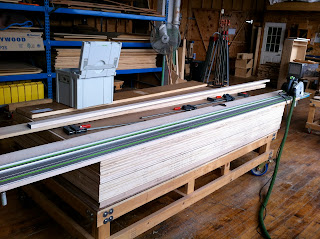As I mentioned recently, I've been able to start working at home again on small projects. This afternoon I took a better stock of the work area at home and cleaned it up a bit. I have a few ideas on what I need to do to make it a more useful/organized work space, but for now, it's looking and functioning a lot better already.
Today, I glued up a drawer. It's my first glue-up in this space, so it feels like a landmark. A small one, but it's reassuring to know that my love for working with wood has finally found a place in my home. That said, it's been a while since I've cut dovetails by hand, let alone glued up a drawer, and it's a good thing I'm getting the practice in. It will be a serviceable drawer, but it's not my finest work. Fitting the drawer into the case was fun, too... It took me almost 10 minutes to figure out why it wouldn't go in. There were still drops of glue in the corners of the case from when I glued up the case almost 2 years ago.
Really long term, I still have a pretty clear memory of the bench I'd originally envisioned building for the space, with a base that was completely filled with drawers, like a shaker workbench. I'm not going to build another bench, but it would be nice to build a cabinet/drawer unit that fits snugly in the frame of this bench. I love the little tool chest that I have in the bench right now, but it just doesn't have the storage space I want.
Lust for more storage space aside, I also have a pretty clear memory of why I wanted a bench at home in the first place. I like writing about woodworking, and I like figuring out how to refine the process. I have a few ideas for bench fixtures that I'd like to put together to help streamline the process of building furniture at home. The ultimate goal is to help people who are working with limited space figure out how to work better, and more efficiently, with the space they do have.
It's funny, in a way. I spend 5 days a week in the shop, working on projects for other people. I spend Saturdays up there, too, doing small personal projects, maintenance, and little stuff. I'm spending 5 days a week in the shop trying to make it pay, I spend Saturdays trying to keep it fun... and I'm still excited about doing bench work at home on Sunday afternoons.

















